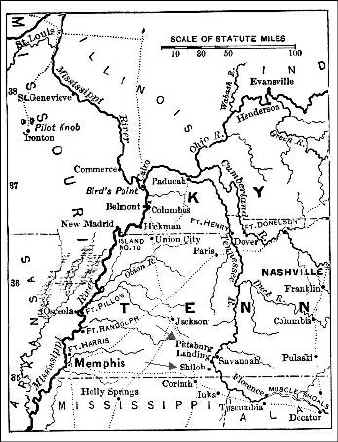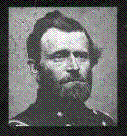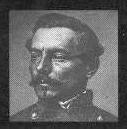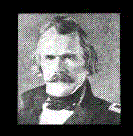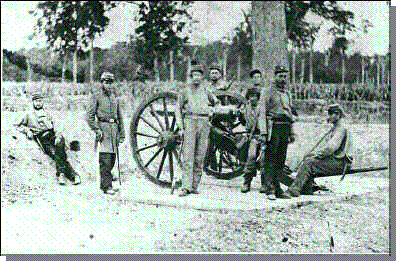By dawn on April 7,
the combined Federal armies numbered 55,000 men. Beauregard, unaware that all of
Buell's army had arrived, planned to continue the attack and drive the Northerners into
the river. At 6 a.m. the Confederates went on the offensive and were, at first,
successful. The stronger Union armies, however, soon began to push the Confederates
back. Realizing that he had lost the initiative, Beauregard tried to break the Union
drive by counterattacking at Water Oaks Pond. The Federal advance was stopped, but
their line did not break. Low on ammunition and food and with 15,000 of his men
killed, wounded, or missing. Beauregard knew he could go no further. He
withdrew beyond Shiloh Church and began the weary march back to Corinth. The
exhausted Federals did not pursue. The battle was over.
|
On April 8, Grant sent Sherman south along the Corinth Road to try to catch
the retreating Confederates. Ten miles out he ran into the Southern rear guard under
Col. N.B. Forrest. Sherman abandoned the pursuit.
|
In late April and May
the Federals crept toward Corinth and seized it, while an amphibious force on the
Mississippi was destroying the Confederate River Defense Fleet and capturing
Memphis. From these bases the Federals pushed down the Mississippi to besiege
Vicksburg. After the surrender of Vicksburg and the fall of Port Hudson in Louisiana
in the summer of 1863, the Confederacy was effectly cut in two. The war went on.
|
In terms of the Poche
Family, the majority of the family was in the 18th Louisiana Infantry and the 30th
Louisiana Infantry. The 18th fought at Shiloh, Mississippi in 1862 and exactly two
years later to the day, it was fighting at the Battles of Sabine Crossroads (Battle of Mansfield) and Pleasant Hill in western
Louisiana. At both battles, the 48th Ohio Veteran Volunteer
Infantry was also engaged. To get a different perspective about life "on
the other side" read their Regimental
History.
|
The plight of the Pochés of
the 18th Louisiana at Shiloh was described in the Journal of the Orleans
Guard:
|
"6th-At 5 o'clock ordered into
line of battle; marched to and fro until 8, through woods and fields. At about
half-past 8 passed through the abandoned camp of the 6th Iowa. Found there a
bountiful supply of bread, hot from the oven, any amount of provisions, wine, fruits, and
other delicacies; enough all together to feed ten regiments. Halted there for a half
hour. Passed soon after to another camp, abandoned by its occupants at our approach,
not without their firing a parting volley. The Crescent [Crescent Regiment] at this
camp diverged (owing probably to the dense woods) from the line of march of the Orleans
[Orleans Guards Battalion] and the 18th Louisiana. After half an hour's march
further on, just as it was preparing to assault another camp, it was assailed by a brisk
musketry fire, which proved to be from the 6th Kentucky and a Tennessee regiment.[27th
Tennessee Infantry] These troops, at sight of the blue uniform brought out
from New Orleans, mistook the Battalion for the enemy. Two men were killed by this
error.
|
At five o'clock joined the 18th La. in
a ravine, about half a mile from the Tennessee River. Remained exposed to the enemy's fire
from the plateau of the hill in front of its line of battle, and to the shells of the
enemy's gunboats.
|
The Battalion here awaited the order of
General Preston Pond, who stood twenty yards off; the enemy meanwhile was a half mile from
the Tennessee river, which they had fortified. They were now awaiting our attack,
having already repulsed that of the 16th Louisiana.
|
